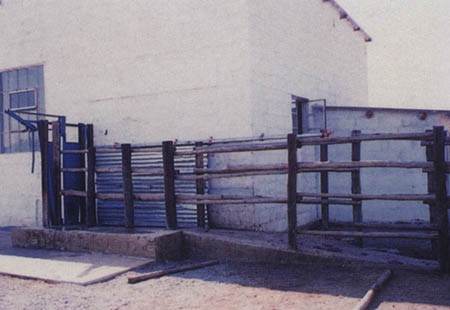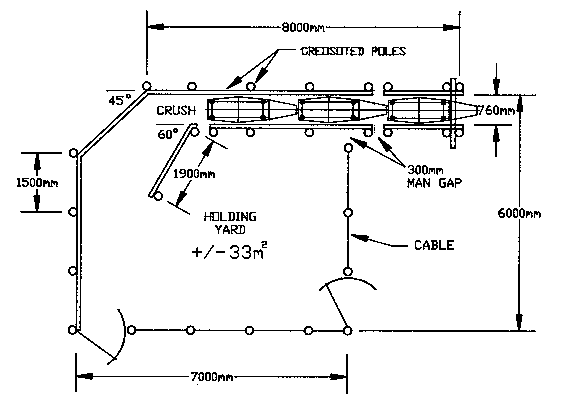The most important part of a handling facility is the cattle crush or race, and everything should be planned around the crush.
Start with the crush, ensuring that it is sited on a slope in such a way that cattle walk uphill in the crush. Ideally, the rise should not be steep (a slope of 1:70 is ideal) and the crush should be angled across the slope. Rain will then not run down the length of the crush and cause erosion. Drainage is across the width of the crush, washing the dung inside the crush away from the side where the people are standing.
Most people work with cattle from the right-hand side i.e. they use their left hands to do rectal examinations.
The width of a crush varies with the size of the cattle that will enter the crush, from 680 mm for smaller animals up to 750 mm for very large cattle.
A height of 1 500 mm is acceptable for most breeds of cattle, whereas, with larger, wilder cattle, a height of 1 900 mm should suffice.

A crush can vary in length but should not be shorter than two cow lengths because cattle have a herding instinct, and should an animal refuse to enter a crush, placing a tame animal in front often entices other animals to follow. Where a crush is more than 14 animals long, efficiency is lost because people working with the cattle need to walk too far from the pre-holding area to the front of the crush and, unless spacers are provided, cattle in a long crush tend to move back when handled and crush animals in the rear. A crush length of 1 700 mm per medium-sized cow is usually satisfactory. Vertical posts should be placed at one animal interval.
Many farmers like to provide for a smaller crushes where calves can be handled. However, a full-sized crush can be used for calf management by adding barriers lower down. Stringing a cable between the ground and lowest horizontal pole and between the first and second horizontals prevents calves from escaping. The handler then enters the crush and works with the calves in the crush, with the neck clamp closed and the rear of the crush closed with poles. With larger calves, crush width can be reduced by hanging motor-car tyres or poles inside the crush.
Although a neck clamp is useful, a crush with a gate in front can be used for most operations by using some means to immobilise animals, such as tying their heads to the side of a crush using a leather thong, which will not cut into their skins. Loose poles placed across the crush in front of vertical posts are usually all that is needed to prevent animals from exiting at the rear.

Click here to view a video that explains the Taltec systems for cattle handling ease.